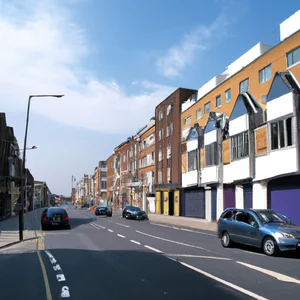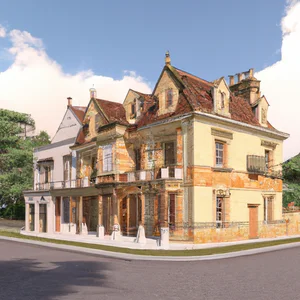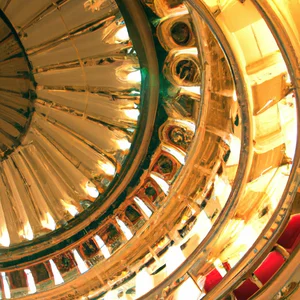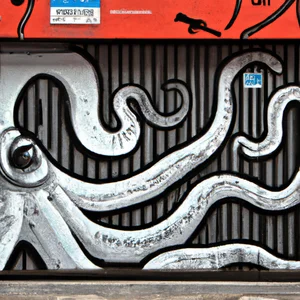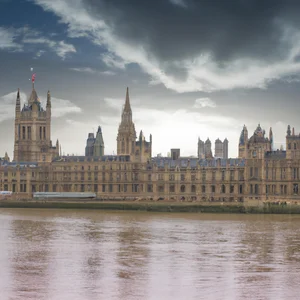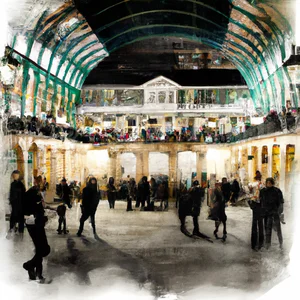Book your experience
Canary Wharf: London's new skyline and financial hub on the water
Canary Wharf: a corner of London that has become truly iconic, eh? It’s as if they took a handful of skyscrapers and put them floating on the water, creating a panorama that takes your breath away. I remember the first time I went there, it was a sunny day and the water shone as if they had scattered glitter everywhere.
This place is not just a lookout, but is also a real financial center. I mean, if you think of London, you can’t help but think of Canary Wharf, right? It’s like the beating heart of the economy, with all those banks and companies looking down on you.
And then, there’s that slightly frenetic atmosphere, as if every person there has an important appointment, a bit like when you go to a restaurant and realize that everyone is waiting for their dish, only here it’s about of money and business. I think it’s a place that makes you feel alive, even if, to be honest, sometimes it can feel a little too serious.
But come on, who doesn’t love getting lost in the shops and restaurants? I’ll tell you, last summer, I went to eat in a nice little place overlooking the dock. I ordered a very fresh fish dish and, honestly, I wasn’t expecting it: it was mouth-watering!
In conclusion, Canary Wharf is a strange but fascinating mix of modernity and nature, a sort of glass and steel jungle overlooking the water. In short, it’s always worth dropping by, even just for a walk. Maybe I wouldn’t live there, but I would certainly love to go back!
Canary Wharf: the beating heart of London
An exciting experience
I remember the first time I set foot in Canary Wharf, a mix of modernity and dynamism that immediately caught my attention. As I walked along the cobbled streets, with skyscrapers standing like sentinels of glass and steel, the sound of work in progress was palpable. Office workers hurried to their offices, while tourists stopped to take photos of this iconic new skyline. In that moment, I realized that Canary Wharf is not just a financial hub, but the true beating heart of London.
Practical information
Today, Canary Wharf is home to over 120,000 workers and a host of world-class companies, including household names such as Barclays and Citigroup. For those looking to explore this fascinating area, the best way to get there is via the tube, with Canary Wharf station on the Jubilee Line, or the DLR (Docklands Light Railway) service, which offers unique views along the way. It is important to note that, despite its reputation as a financial centre, Canary Wharf has also developed a lively and welcoming atmosphere, with green areas and public spaces that invite socialising.
An insider tip
If you want to have an authentic experience, I recommend visiting the Crossrail Place Roof Garden, a green oasis hidden above Canary Wharf train station. Here, among exotic plants and quiet paths, you can enjoy a break from the hustle and bustle of city life. This garden, designed to reflect the modern architecture of Canary Wharf, is a place where residents and workers come together to relax and socialize, away from the noise of the streets below.
Cultural and historical impact
Canary Wharf hasn’t always been a hotbed of skyscrapers and finance. Until the 1980s, it was a declining cargo port. Its transformation into a financial center has had a significant impact on London’s economy, helping to shape the modern city we know today. This change has also led to greater cultural diversity, making the area a crossroads of people and ideas.
Sustainability: a green model
In recent years, Canary Wharf has made significant steps towards sustainability. Many of the buildings are equipped with eco-friendly technologies and there are initiatives to encourage visitors to use public transport and bicycles. The promotion of responsible tourism practices is an integral part of the identity of this area, making it a shining example of how urbanization can coexist with eco-sustainability.
An experience worth trying
For a truly unique experience, try taking one of the Thames River cruises departing from Canary Wharf. These trips will allow you to admire the panorama of the new London skyline from a completely different perspective, giving you the chance to discover the city from its river, a central element in London’s history.
Myths to dispel
A common misconception about Canary Wharf is that it is an area exclusively for business people and professionals. In reality, the area is much more accessible and lively than you might think. Markets, restaurants and welcoming public spaces are open to all, making it an ideal destination for families and tourists too.
Final reflection
As you pass through this vibrant financial centre, ask yourself: what does Canary Wharf really mean to you? Is it just a workplace, or can it become a symbol of innovation and rebirth? Next time you visit London, consider exploring this fascinating corner and be amazed by its infectious energy.
Modern architecture: a new iconic skyline
A personal experience
I remember the first time I set foot in Canary Wharf. As I walked among the glittering skyscrapers, the air was filled with a mix of modernity and ambition. The reflections of the windows captured the sunlight, creating a play of lights that seemed to dance above the heads of passers-by. I was surrounded by architecture that told stories of innovation and progress. Each building, with its bold design, seemed to invite me to explore a world of opportunities.
Practical and up-to-date information
Canary Wharf has over time become one of the main financial centers in the world, but what often surprises visitors is its breathtaking skyline. Among the most iconic skyscrapers, we find One Canada Square, which with its 235 meters of height is the second tallest building in the United Kingdom. An excellent source for learning more about the architecture of this area is the official Canary Wharf Group website, where you can find details on future projects and ongoing architectural initiatives.
Unconventional advice
If you want a panoramic view without having to deal with long queues at tourist attractions, I recommend visiting the Sky Garden at 20 Fenchurch Street. Even though it’s just a short walk from Canary Wharf, this rooftop garden offers spectacular views of the London skyline, with no entry fee. Remember to book in advance!
The cultural and historical impact
Canary Wharf’s modern architecture is not just a symbol of economic development; it also represents a cultural change. In the 1980s, the area was a disused port, but its transformation into a financial and commercial center has attracted professionals from around the world, helping to create a multicultural and vibrant community. Each building tells a part of this evolution, with styles ranging from contemporary minimalism to bold and innovative design.
Sustainable tourism practices
In an age where sustainability is paramount, Canary Wharf stands out for its efforts to promote eco-friendly practices. Many buildings are designed with sustainable technologies, such as the use of recycled materials and energy saving systems. Walking among these skyscrapers also means being able to appreciate the urban greenery: parks and gardens are an integral part of the design, offering spaces for relaxation in a metropolitan context.
An activity worth trying
Don’t miss the opportunity to take part in a guided architectural tour. These tours offer a unique perspective on how it was conceived and developed this area, with expert guides who share anecdotes and curiosities about the individual buildings. You can find information on the official Canary Wharf website.
Myths and misconceptions
A common myth about Canary Wharf is that it is only accessible to those working in the financial sector. In reality, the area is open to everyone and offers numerous attractions, including restaurants, shops and exhibition spaces, making it a perfect destination for tourists too.
Final reflection
As I observed the contrast between the skyscrapers and the blue sky, I asked myself: how can we embrace the future without forgetting the roots of our past? Canary Wharf is not only an example of modern architecture, but also a symbol of how cities they can evolve to face contemporary challenges, always keeping an eye towards tomorrow.
Sailing on the water: unique boating experiences in Canary Wharf
A personal journey among the waves
I still remember the first time I took a boat to Canary Wharf. As the boat moved away from the dock, the landscape began to transform. The imposing glass and steel structures were reflected in the water, creating a play of light that seemed to dance to the rhythm of the wind. This experience affected me deeply, making me realize how much water is an integral part of this lively and modern neighborhood. Sailing along the River Thames offers a unique perspective on London, with every corner telling a story of innovation and progress.
Practical and up-to-date information
Today, there are several options for exploring the Thames, from sightseeing cruises to public ferries. Companies such as Thames Clippers offer frequent services between Canary Wharf and other iconic destinations, such as the London Eye and Greenwich. Sunset cruises are particularly popular, offering a romantic atmosphere and breathtaking views. Be sure to check the official Thames Clippers website for up-to-date timetables and special offers.
An insider tip
If you want a truly unique experience, I recommend booking a private boat charter for a celebration or special event. Many companies offer customizable packages, which allow you to enjoy the view in an intimate and private way. Plus, ask about including a gourmet picnic prepared by one of Canary Wharf’s local restaurants; it will be a delicious way to enjoy British cuisine while you browse.
The cultural impact of navigation
Sailing on the Thames is not just a way to get around, it’s also a key part of London’s history. The river played a crucial role in the city’s development, serving as a commercial and cultural route. Today, Canary Wharf is a symbol of modernity, but its roots lie deeply in London’s maritime tradition.
Sustainability and responsible tourism
Many cruise operators are making efforts to reduce their environmental impact. Some boats are equipped with low-emission engines and adopt separate waste collection practices on board. Opting for experiences that follow these principles not only enhances your experience, but also helps protect London’s marine environment.
Soak up the atmosphere
Imagine sitting on a boat, the wind caressing your face as the skyscrapers of Canary Wharf pass by. The sound of crashing water and the scent of the river create an atmosphere of calm and wonder. This experience is not just a trip, but a total immersion in London life.
An activity worth trying
I recommend taking a thematic cruise, such as the one dedicated to the history of London or its famous floating pubs. These cruises will not only offer you a panoramic tour, but also historical insights that will enrich your knowledge of the city.
Myths and misconceptions
A common misconception is that Thames cruises are only for tourists and that there is nothing authentic to discover. In fact, many Londoners use ferries on a daily basis, and the experience of sailing on the river is an authentic way to see the city from a different perspective.
A final reflection
Sailing on the water in Canary Wharf is more than just a pastime - it’s an opportunity to connect with London’s history and culture. Have you ever wondered what it would be like to see the city from its river, instead of its streets? This experience invites you to discover a London that few have the privilege of exploring.
Local taste: markets and restaurants to discover
A culinary journey through the flavors of Canary Wharf
When I first set foot in Canary Wharf, my gastronomic curiosity guided me towards the Canary Wharf Market, an enchanting place that comes alive every Thursday and Friday. Among the colorful stalls, I savored a delicious pulled pork sandwich that exceeded my expectations and made me discover the authentic side of local cuisine. This isn’t just a market; it is a sensory experience that reflects the vitality and cultural diversity of London.
Unmissable markets and restaurants
Canary Wharf is known for its modern architecture and glittering skyscrapers, but its food offering is equally amazing:
- Canary Wharf Market: A great starting point for exploring local and international foods. Here you can find everything, from artisanal delicacies to ethnic dishes.
- The Ivy in the Park: An elegant restaurant with a menu that celebrates fresh, seasonal ingredients, perfect for dinner after a day of exploring.
- Roka: A Japanese venue offering a fine dining experience, with freshly prepared dishes and a lively atmosphere.
An insider tip
If you want a unique gastronomic experience, don’t miss the Gourmet Food Market held every Saturday at Montgomery Square. Here you can discover new chefs and innovative dishes, far from the beaten tourist track. Taste the tasty local dishes and browse through the various stalls, chatting with the producers themselves.
The cultural impact of gastronomy
Canary Wharf’s culinary culture is a reflection of its history as an international financial hub. The restaurants and markets here not only offer food, but tell stories of travel and culinary traditions from around the world. This mix of cultures is what makes Canary Wharf such a fascinating place.
Sustainability and responsibility
Many restaurants and markets in Canary Wharf are adopting more sustainable practices, such as using organic and local ingredients. Some restaurants, like The Good Life Eatery, are committed to reducing food waste and promoting healthy, responsible eating. Choosing to eat here also means supporting a greener future.
An activity worth trying
In addition to visiting the markets, I recommend taking part in a guided food tour. These experiences will not only lead you to discover delicious dishes, but will also allow you to learn about the history and food culture of Canary Wharf.
Myths and misconceptions
A common misconception is that Canary Wharf is only for those working in the financial sector and that its dining options are limited to expensive restaurants. In fact, you can find a variety of options here, from street food stalls to cozy bistros, making it accessible to everyone.
A final reflection
Next time you’re in Canary Wharf, take a moment to explore its food scene. Which dish surprised you the most? The variety and quality of food here can really change the way we perceive this iconic neighborhood. Let yourself be surprised by the flavors and stories that each dish has to tell.
Hidden History: The Lesser Known Side of Canary Wharf
A Journey in Time
I vividly remember the moment I discovered the hidden history of Canary Wharf. As I strolled along the docks, past glittering skyscrapers and trendy shops, I came across a small information board talking about the area’s maritime past. Once upon a time, before its transformation into a financial hub, Canary Wharf was a lively port area, the beating heart of commercial activities linked to the tea and spice trade. This contrast between the past and the present struck me deeply, revealing a side of London that few know.
Discovering the Past
If you want to delve into the lesser-known history of Canary Wharf, I recommend visiting the Museum of London Docklands. Located in a former warehouse shed, this museum offers a fascinating insight into the history of the area, from its origins as a trading port to its evolution into a modern financial centre. Interactive exhibits and historical films will take you back in time, making you feel part of a bygone era.
Insider advice
A little-known tip is to explore the Docklands at the weekend, when Canary Wharf market comes alive with local stalls and artisans. Here you can find fresh produce, crafts and street food, but what makes this experience unique is the chance to converse with the vendors, many of whom are local residents and can share fascinating stories about the community and its history.
The Cultural Impact
The transformation of Canary Wharf has had a major impact on London culture. The area has seen the abandonment of a maritime tradition to embrace a service-based economy. However, signs of the past are still visible, with some preserved historic buildings telling the story of a time when maritime trade was king. This duality between ancient and modern creates a vibrant and unique atmosphere, enriching the visitor experience.
Sustainability and Responsible Tourism
In a context of growing environmental awareness, it is essential to remember that the story of Canary Wharf is also a story of sustainability. The area has made significant progress in becoming a model of sustainable urban development, with vertical gardens and green spaces that bring nature back into the urban context. When exploring this area, consider using public transport or bicycles, helping to reduce the environmental impact of your trip.
Immerse yourself in the Atmosphere
Walking along the River Thames, admiring the modern architecture that defies the sky, while the cool wind ruffles your hair, is an experience you won’t forget. The sunlight reflecting on the water creates a play of colors that makes the atmosphere almost magical. Don’t forget to bring your camera to capture unique moments.
An Activity to Try
I recommend joining a guided walk organized by local experts, which often includes intriguing stories and anecdotes about the history of Canary Wharf. These walks not only provide an opportunity to learn, but also to socialize with other travelers and residents, creating bonds that go beyond just tourism.
Myths and Misconceptions
A common misconception about Canary Wharf is that it is just a working area, devoid of life or culture. In fact, in addition to the skyscrapers, there are art spaces, local markets and community events that make this area vibrant and welcoming. It is a place where history and modernity coexist, offering authentic experiences to those willing to look beyond the surface.
A New Perspective
As you explore the lesser-known side of Canary Wharf, I invite you to reflect on how places can evolve and transform. What do stories from the past tell us about our present life? Have you ever wondered what the future of this area is and how it will continue to change? The story of Canary Wharf is only just beginning, and every visit is an opportunity to discover something new.
Contemporary art: galleries not to be missed
It’s a bright morning in Canary Wharf and, as I stroll among the glittering skyscrapers, I come across a small art gallery, the David Roberts Art Foundation. Intrigued, I decide to enter and discover a world of creativity and innovation that lies behind the doors of this financial district. The works on display, which range from sculpture to video art, transport me to a universe where contemporary art challenges conventions and invites reflection. Here, art is not just a decoration, but a real experience that enriches the urban context.
Unmissable galleries
Canary Wharf is not only the beating heart of London’s finances, but also a vibrant cultural centre. Among the galleries not to be missed, I would like to point out:
- Cabot Square: hosts temporary installations by emerging and established artists, combining nature and art in a public space.
- The Space: an incubator for contemporary art, where bold and provocative exhibitions can be found.
- Canary Wharf Arts + Events: a program that includes site-specific works, often outdoors, which transform the urban landscape into an open-air gallery.
An insider tip
If you want to have a unique experience, visit the DRAWin gallery during the contemporary art week. Here, local artists exhibit their works and offer interactive workshops. It is an unmissable opportunity to come into direct contact with art and the artists themselves.
Cultural and historical impact
Contemporary art in Canary Wharf is not just decoration; represents a turning point in the perception of this neighborhood. In recent years, the transformation from a purely commercial area to a cultural center has attracted not only industry professionals, but also families and tourists. This evolution has helped create a sense of community, where art becomes a common language.
Sustainability and art
Many of the galleries are committed to sustainability, promoting responsible practices and using recycled materials. For example, public art often uses natural elements and sustainable materials, combining aesthetics and respect for the environment. This eco-conscious approach is crucial to the future of art, especially in an urban context like Canary Wharf.
An experience worth trying
I recommend you take part in one of the guided tours organized by local galleries. These art walks will not only lead you to discover extraordinary works, but also to learn about the history and backstories of the artists.
Myths and misconceptions
A common myth is that contemporary art is elitist and inaccessible. In fact, Canary Wharf offers open spaces and free galleries that welcome visitors from all walks of life. Art is for everyone and can be a deeply personal and engaging experience.
A final reflection
After exploring the world of contemporary art in Canary Wharf, I wonder: how can art influence our perception of an urban space? Next time you visit London, take a moment to immerse yourself in these artistic experiences and let yourself be be inspired by the creativity that surrounds this extraordinary district.
Sustainability in Canary Wharf: a green model
When I visited Canary Wharf for the first time, I didn’t expect to discover a corner of London so committed to sustainability. As I walked among the glittering skyscrapers, a small vertical garden caught my attention. It was an installation that not only beautified the area, but also helped improve air quality. This chance meeting made me understand that here, among the modern structures, there is a beating heart of innovation ecological.
A concrete commitment to the environment
Today, Canary Wharf is much more than a financial centre; it is a shining example of how urbanization can go hand in hand with sustainability. According to the Canary Wharf Group management office, 95% of the energy used comes from renewable sources. Furthermore, the neighborhood is equipped with cutting-edge recycling plants and a rainwater collection system that serves to irrigate the numerous gardens and parks.
An insider tip
If you really want to understand Canary Wharf’s commitment to sustainability, take a moment to visit Jubilee Park, where you can admire the sensory garden designed to stimulate the five senses. Furthermore, don’t miss the opportunity to take part in one of the free guided tours offered by Canary Wharf Group, which will take you to discover the greener aspects of this neighbourhood.
A significant cultural impact
Canary Wharf’s transition from a port area to a model of sustainable development is not just a matter of green practices; it is a cultural change that reflects a growing awareness of the importance of sustainability in the urban context. This has inspired many other cities to follow suit, putting London at the forefront of the fight against climate change.
Responsible tourism practices
If you want to visit Canary Wharf responsibly, consider using public transport. The area is well connected via the Underground and Docklands Light Railway (DLR) service, reducing the environmental impact of your journey. Additionally, many local restaurants use organic and locally sourced ingredients, making every meal an opportunity to support the local economy.
Soak up the atmosphere
Imagine strolling along the waters of South Dock, surrounded by art installations that reflect a commitment to sustainability, as the sun sets behind the skyscrapers. The view is breathtaking and the air is fresh, a tangible sign that even in a metropolis like London, nature finds its place.
An experience worth trying
I recommend you explore the Canary Wharf Climate Action Group, where you can learn more about local initiatives and perhaps get involved in community events. It’s a way to connect with residents and visitors who share a common vision for a greener future.
Myths to dispel
A common misconception is that financial centers such as Canary Wharf are indifferent to environmental issues. In fact, this area is demonstrating that even areas with a high density of economic activity can be pioneers in sustainability.
A final reflection
As you drive away from Canary Wharf, ask yourself: How can we all help make our cities more sustainable? The answer may lie in how we choose to travel, consume and live every day. Sustainability is not just a trend, it is the key to a better future.
Exclusive events: festivals and events to experience
An unexpected encounter
Imagine being in Canary Wharf during the Waterfront Festival, an annual event that transforms the neighborhood into a vibrant stage of culture and creativity. I distinctly remember the first time I attended: the scent of street food mixed with the tunes of street musicians, while families enjoyed the sun on the banks of the river. In that moment, I realized that Canary Wharf is not just a financial centre, but a place where the community comes together to celebrate and celebrate life.
Practical information
The Waterfront Festival is usually held in mid-summer, but Canary Wharf’s events calendar is always rich and varied. From outdoor film screenings to art exhibitions, there’s always something happening. You can check the official Canary Wharf website for updates on events and festivals, where you will also find information on how to participate and register.
An insider tip
A little-known tip is to arrive a little early to explore the artisan markets. Here you can find local products, crafts and culinary delights that you won’t find in restaurants. Artisans are often willing to share stories and secrets about their work, making the experience even more authentic.
Cultural impact
Canary Wharf has a rich and amazing history. Originally a port area, it underwent a radical transformation in the 1980s and 1990s. Today, cultural events not only celebrate this metamorphosis, but also help strengthen the neighborhood’s identity as a meeting place between different cultures and communities. This mix of influences makes Canary Wharf a crossroads of creativity and innovation.
Sustainable tourism
In an age where sustainability has become a priority, Canary Wharf is taking steps forward. Many events feature eco-friendly practices, such as the use of biodegradable materials and recycling. By attending events in Canary Wharf, you can contribute to responsible tourism, supporting initiatives that aim to reduce environmental impact.
A vibrant atmosphere
Walking the streets of Canary Wharf during a festival is an experience that touches the senses. The twinkling lights of the skyscrapers reflect on the water, creating a magical atmosphere. The laughter of children, the sound of music filling the air and the warmth of people gathering to have fun transform the neighborhood into a living stage.
An activity worth trying
If you’re in Canary Wharf during an event, don’t miss the chance to take part in one of the interactive workshops, where you can learn how to create a craft or cook a local dish. These experiences will not only enrich you, but also allow you to connect with the community.
Myths to dispel
Many believe that Canary Wharf is just a place for business and finance. However, this perception is misleading. The reality is that the neighborhood is a pulsating hub of cultural and community events that offer something for everyone. It’s a place where work and play can coexist in harmony.
A final reflection
After experiencing the festival atmosphere in Canary Wharf, you’ll wonder: what other surprises does this neighborhood hide? The beauty of Canary Wharf lies in its ability to continually reinvent itself, offering new experiences that defy expectations. Are you ready to find out more?
Exploring the secret gardens of Canary Wharf
A personal experience
The first time I set foot in Canary Wharf, the grandeur of the skyscrapers immediately struck me. But the real surprise came when, wandering through the glass and steel streets, I came across a hidden green corner: one of the secret gardens that dot this area. It was like discovering an oasis in the middle of an urban desert. The scent of flowers and the sound of flowing water transported me away from the hustle and bustle of the financial center, giving me an unexpected moment of peace.
Practical information
Canary Wharf is not only a financial centre, but also offers a number of gardens and green spaces that are worth a visit. Among the best known are Canada Square Park and Wood Wharf, but there are many smaller, less well-known gardens. These spaces are perfect for a lunch break or a relaxing walk. The gardens are easily accessible and often host local events, markets and art installations. I recommend checking the official Canary Wharf website for up-to-date information on upcoming events.
An insider tip
One of the best kept secrets is Jubilee Park, located near Canada Square. This garden offers not only spectacular views of the surrounding skyscrapers, but also corners quiet where you can sit and enjoy a good book or simply observe the world around you. Don’t forget to bring a good coffee from one of the many bars nearby; the atmosphere here is perfect for a moment of relaxation.
Cultural impact
The secret gardens of Canary Wharf are not only a refuge from urban chaos, but also represent a commitment to sustainability and the quality of life of citizens. These green spaces help improve the air and create a healthier environment for workers and visitors. Their presence is a clear example of how modernity can integrate with nature, an increasingly important aspect in the contemporary urban context.
Sustainable tourism practices
Many of the gardens are designed with sustainable gardening practices. For example, water-saving irrigation systems and native plants are used to reduce environmental impact. When you visit, try to respect these spaces, avoiding damaging the plants and following the signs for recycling and waste collection.
A unique atmosphere
Walking through these gardens, you can really feel a special atmosphere. The combination of modern architecture and nature creates a fascinating contrast, inviting reflections on beauty and the balance between urban development and natural life. Every corner seems to tell a story, and every visit can reveal a new surprise.
Activities to try
I recommend you join one of the outdoor yoga sessions that are organized regularly in the gardens. It’s a fantastic way to reconnect with yourself while surrounded by natural beauty, and you’ll also have the opportunity to meet locals.
Myths to dispel
A common misconception is that Canary Wharf is only an area for men in suits. In fact, the Secret Gardens prove that this place has so much more to offer, with spaces for families, artists and anyone wanting to discover a different side of London.
A final reflection
Ultimately, Canary Wharf is a place of contrasts, where modernity and nature coexist in harmony. I invite you to explore these secret gardens and reflect on how important it can be to find moments of tranquility even in the most hectic places. What is your favorite green corner in a big city?
Nightlife: where to have fun after work
An evening in Canary Wharf can be an extraordinary experience, far beyond the frenzy of work. I still remember my first visit to a bar overlooking the river, where the lights of the ships illuminated the water like fallen stars. Between the buzz of people and the clinking of glasses, I realized that this area, despite being known for its business, has a vibrant and surprising nightlife.
Atmosphere and Options
After sunset, Canary Wharf transforms. The skyscrapers seem to come to life, illuminated by lights of various colours. Here, there’s no shortage of venues: from chic cocktail bars like Bōkan, which offers breathtaking panoramic views from the 37th floor, to traditional pubs like The Henry Addington, perfect for a craft beer. The restaurants, such as the Plateau, offer refined dishes and a selection of wines that will delight the most demanding palates.
A unique tip
If you want an authentic and little-known experience, don’t miss Jazz Night at The O2, a short walk from Canary Wharf. This event, held every Thursday, attracts local talent and offers an intimate atmosphere, perfect for those looking to immerse themselves in British music culture.
Cultural impact
Canary Wharf’s nightlife reflects not only the modernity of the area, but also a fusion of cultures. The presence of different communities has led to a diversified gastronomic and entertainment offer, which enriches the experience of those who visit. This melting pot of cultures is also expressed through events such as night markets, where culinary traditions from all over the world meet.
Sustainable tourism
In an age where sustainability is key, many venues in Canary Wharf are adopting responsible practices. For example, several bars and restaurants use local and seasonal ingredients, thus reducing their environmental impact. By choosing to eat and drink in these places, you will not only have fun, but you will also contribute to more sustainable tourism.
An experience worth trying
For an experience that combines relaxation and fun, consider an evening cruise on the Thames. Several companies offer tours that include dinner and live music, allowing you to enjoy the London skyline from a unique perspective.
Myths to dispel
One of the common myths is that Canary Wharf is exclusively an area for business people. In reality, nightlife is accessible to all and offers a variety of options to suit every taste and budget. The neighborhood is also safe and well-lit, making it ideal for a night walk.
Final reflection
After a busy day at work, the idea of discovering Canary Wharf’s nightlife might seem unusual. But I invite you to consider: who said that only work must characterize this area? Next time you’re in London, take a moment to explore this vibrant night scene. What will be your favorite place?

 Architecture and Design
Architecture and Design Cities and Regions
Cities and Regions Culture and History
Culture and History Events and Festivals
Events and Festivals Fashion and Shopping
Fashion and Shopping Food and Wine
Food and Wine Nature and Adventure
Nature and Adventure Unique Experiences
Unique Experiences


















